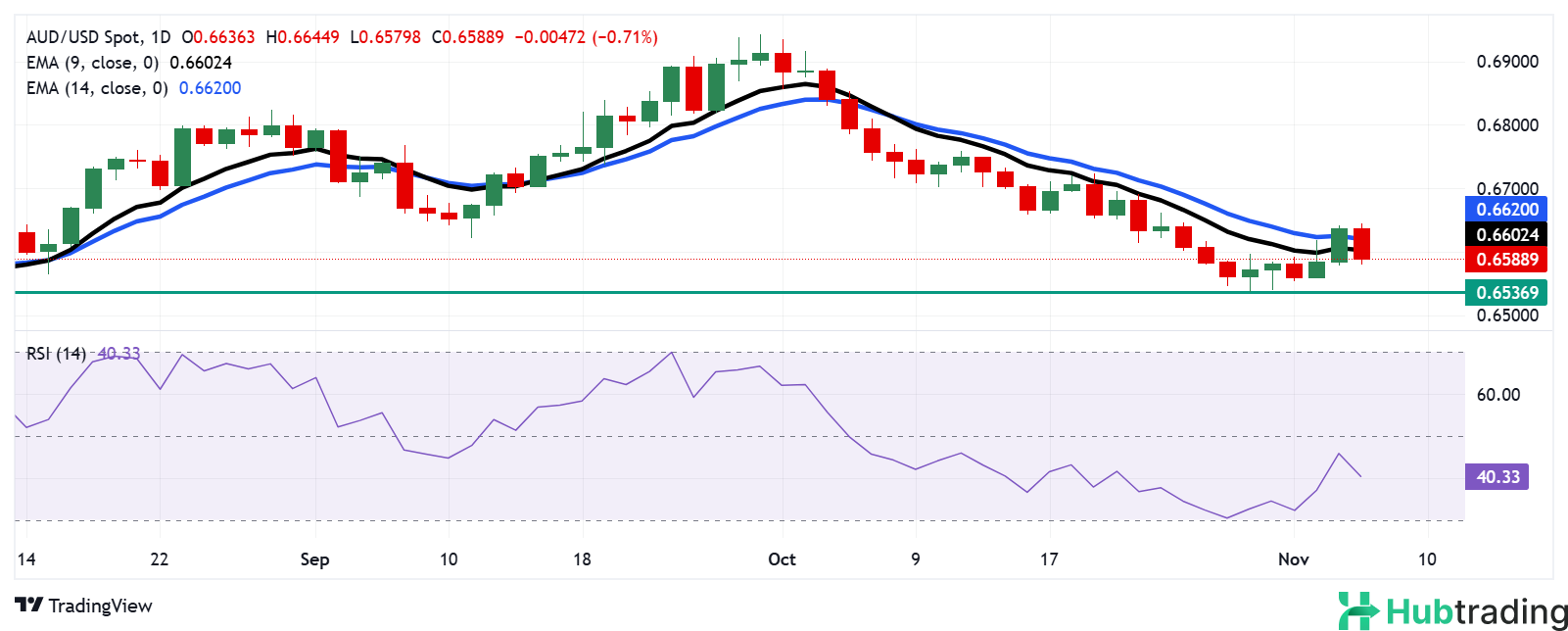- The Australian Dollar weakens as traders remain cautious ahead of the US presidential election results.
- The Aussie Dollar may regain strength following RBA Governor Michele Bullock's hawkish remarks on Tuesday.
- Exit polls in Georgia show Trump with a 10% lead over Harris, based on less than 1% of votes counted.
The Australian Dollar (AUD) retraces its recent gains against the US Dollar (USD) on Wednesday, as market sentiment turns cautious ahead of the US presidential election results. The AUD/USD pair weakens amid the strengthening of the USD, driven by growing optimism in Trump trades, with Republican candidate Donald Trump leading Democratic nominee Kamala Harris in the polls.
Polling data indicates a tight race, with Trump currently holding a slight edge over Harris. On Kalshi, Trump leads 57% to 43%, while Polymarket shows a wider gap at 60.7% for Trump and 39.5% for Harris. Despite Trump's lead, the race remains competitive, and market attention is focused on the election outcome.
Markets are also closely watching the Federal Reserve's interest rate decision on Thursday, with expectations of a 25 basis point cut. The CME FedWatch Tool currently shows a 96.4% probability of a quarter-point rate reduction in the November meeting.
The AUD saw initial strength after the Reserve Bank of Australia (RBA) decided to hold the Official Cash Rate (OCR) steady at 4.35% on Tuesday. Governor Michele Bullock reaffirmed a hawkish stance, emphasizing the need for restrictive policy to combat persistent inflation and a robust labor market.
Additionally, Australia’s latest Purchasing Managers Index (PMI) showed positive growth in the services sector, helping offset manufacturing declines.
Daily Digest Market Movers: The Australian Dollar weakens as market sentiment remains cautious ahead of the US election results
- Exit polls from Wisconsin show Trump leading with 56% of the vote, while in North Carolina, Trump and Harris are in a tight race, with 50% of votes counted. In Michigan, Harris' lead has narrowed from 61% to 53%.
- Early exit polls in Georgia indicate Trump with a 10% lead over Harris, based on less than 1% of votes counted, signaling momentum for Trump, though results remain uncertain.
- Preliminary Pennsylvania exit polls show Harris leading with 71% of the vote, with 8% of the expected votes counted.
- The US ISM Services PMI rose to 56.0 in October, surpassing expectations, while the S&P Global Services PMI came in at 55.0, slightly below forecasts.
- Australia’s Judo Bank Services PMI improved to 51.0 in October, above expectations, signaling growth in the services sector.
- The TD-MI Inflation Gauge showed a 0.3% month-over-month increase in October, the highest since July, and an annual rise of 3.0%.
- ANZ Australia Job Advertisements increased by 0.3% month-over-month in October, continuing the trend of slow growth.
- China’s Commerce Minister Wang Wentao met with Australia’s Trade Minister Don Farrell, with China hoping for a fairer business environment in Australia.
Technical Analysis: The Australian Dollar falls below 0.6600 and the nine-day EMA
The AUD/USD pair trades around 0.6590 on Wednesday, showing signs of continued bearish momentum. The pair has dropped below the nine- and 14-day Exponential Moving Averages (EMAs), signaling downward pressure. The 14-day Relative Strength Index (RSI) remains below 50, reinforcing the bearish outlook.
Immediate support is seen near the three-month low of 0.6536, with further downside potential toward the psychological level at 0.6500.
On the upside, resistance is located at the nine-day EMA at 0.6603, followed by the 14-day EMA at 0.6620. A break above these levels could signal a potential rally towards the key resistance level at 0.6700.
AUD/USD Daily Chart






